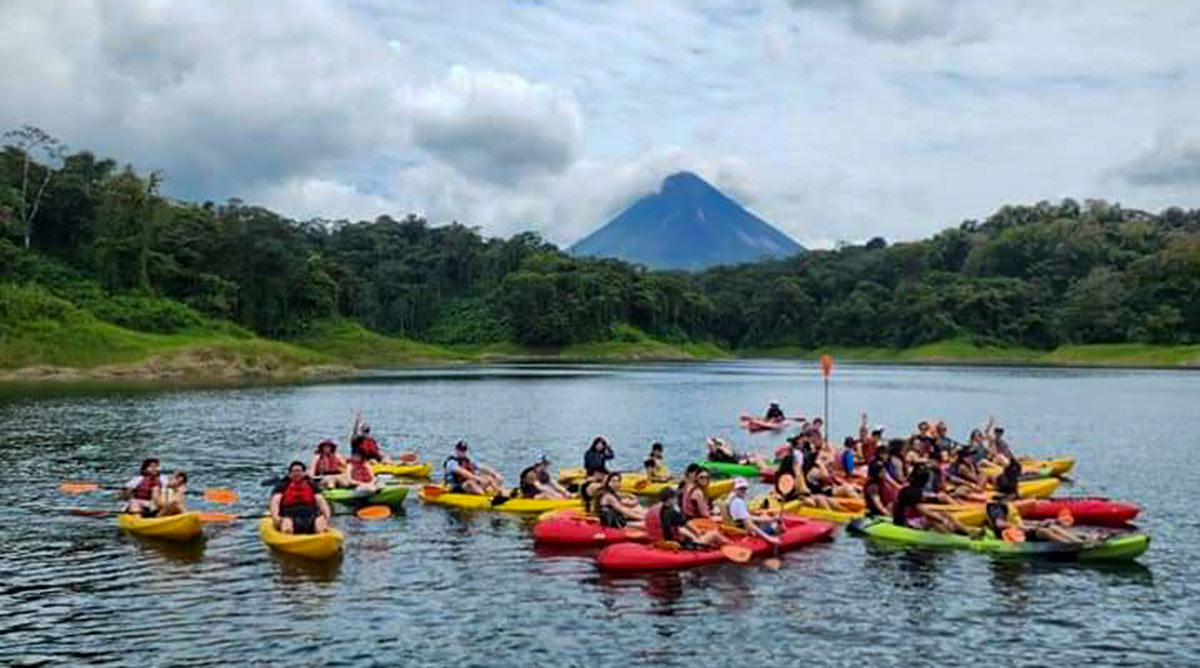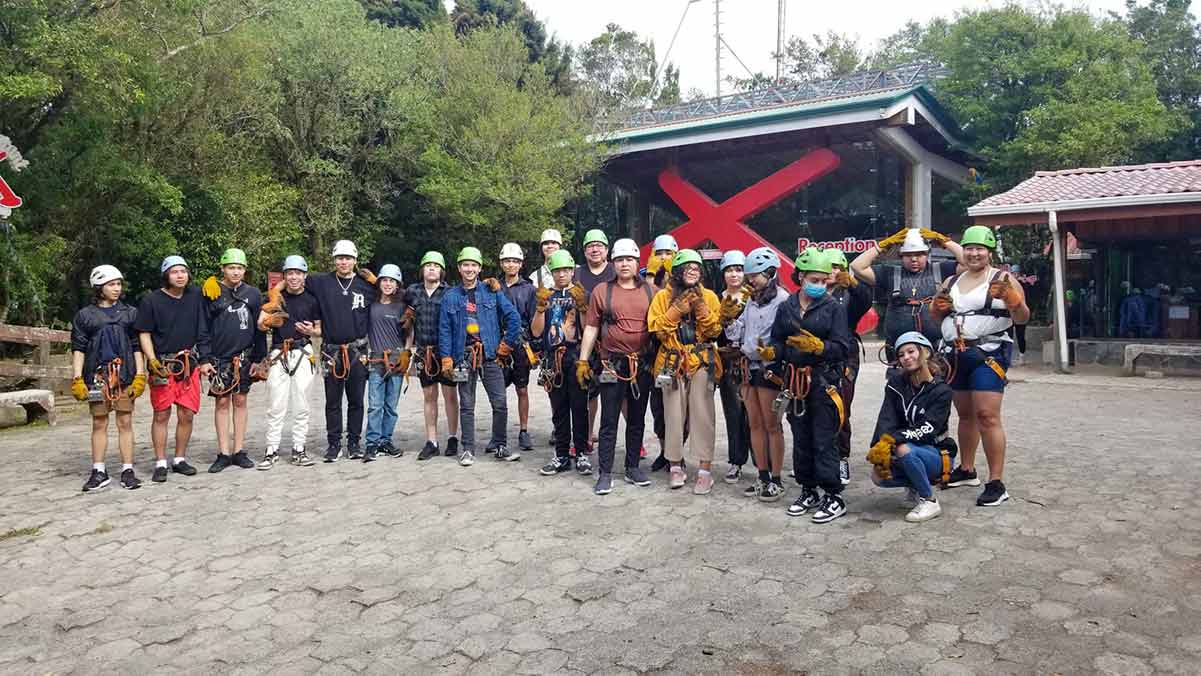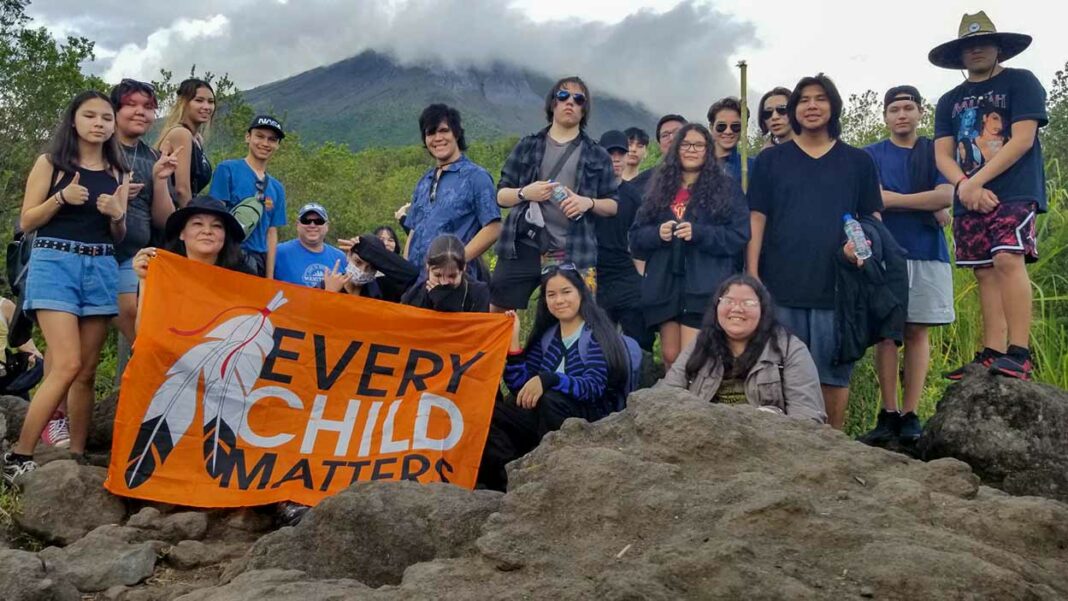by Michael Erskine
WIIKWEMKOONG—A group of high school students from Wiikwemkoong travelled to Costa Rica over the March Break as part of an innovative environmental studies class designed by teacher Jason Thibault. Not only did the Wiikwemkoong students get to engage with students from other parts of Canada and their Costa Rican hosts, but they came home eligible for a high school credit—the first course of its kind in the country.
Students departed Wiikwemkoong High School after being loaded aboard a bus departing for the Sudbury airport at 4:30 am on March 8, returning home around noon on March 17. The intervening week was an action-packed schedule that took the students to new heights, both academically and literally.
On the first day, the students settled into their first hotel in San José, the capital city in the Arenal region of Costa Rica—taking some time to acclimatize to the much warmer weather. Most days temperatures ranged between 26° and 30°C. For most students, it was the first time they had travelled outside the province, let alone the country. They also met the tour director, Gustavo and bus driver Chepe, who would be their companions for the coming week.
“We caught a bus to the airport in Sudbury and then a plane to Toronto where we caught a bigger plane to Costa Rica,” said Adrian Kat, one of the students on the trip. “I hoped we would stop in LA, but we didn’t,” he laughed. Still, the students were not disappointed with days featuring 12 hours of daylight.
The students covered all seven provinces of Costa Rica, staying in four hotels, averaging two days in each.
“The first day we just chilled out, got used to it,” said Carmen Wemigwans.
“The guy who toured the coffee plantation spoke a little bit,” said Adrian, “we tried to talk to Chepe, but he would just look at you, smile and give a big thumbs up.”
For their part, the students picked up a bit of Spanish.
The second day the students were taken on a tour of a coffee plantation, getting an up close and personal introduction to one of Canada’s favourite morning beverages before heading to Arenal Volcano National Park. Travelling up a steep mountain path, students could see the volcano in the distance.
“We went hiking up a trail that had a nice view of the volcano and lake,” said Adrian.
Created in November 1991, Arenal Volcano National Park covers an area of 30,000 acres (12,000 hectares), including four major climactic life zones, the dormant Cerro Chato Volcano and the Cerro Los Perdidos (“Lost Mountain”). Students were treated to the impressive and near-perfect cone of the 1,633 meter (5,358-foot) high Arenal Volcano. The picturesque volcano belies the immense natural power that lies within.
That power can prove devastating. The Arenal volcano eruption in 1968 destroyed 232 square kilometres of land, herds of cattle and important crops and led to the deaths of 87 people—catching the three villages of Tabacón, Pueblo Nuevo and San Luís in its pyroclastic flows. The volcano is currently in a dormant phase and park rangers keep a close eye to ensure safety of their charges.
There are more than 500 bird species identified within the park, that’s roughly 53 percent of all the birds to be found in Costa Rica. There is also a wide variety of flora and other animals in the park, including three kinds of monkeys, red brocket deer, ocelots, pumas and tapirs. The striking aspect of the plant life found on the trails compared to Northern Ontario is the size of the leaves.
“People would cut the leaves and use them for an umbrella,” said Adrian.
Day three was all about kayaking on Lake Arenal, with a visit to La Fortuna Waterfall, participation in a local exchange and a visit to the local hot springs. “They took sugar cane and processed it into candy,” said Mr. Thibault.
“They showed us how to make stuff,” said Carmen, tortillas and banana bread. “That was good banana bread,” agreed Adrian. The students made toffee with the boiled down cane sugar.” The result was similar to maple candy. “It was called ‘sabato.’”
“The hot tubs at the hotels were not very hot,” said Carmen. “They were lukewarm. But the higher up you went at the hot springs, the hotter the water in the springs.”
Day four saw the students travelling to Monteverde and a local food workshop. Food is usually near and dear to the hearts of travellers, and the Wiikwemkoong students were struck by the inclusion of fried bananas (plantains) at every meal. Foods on offer were the familiar stuff of hotel buffets the world over.
Monteverde is famed for its canopy adventure into the Santa Elena Cloud Forest Reserve.
Established in 1972 by a coalition of scientists from the Tropical Science Center (TSC) and Quakers from the local community to protect one of the last tracts of pristine cloud forest in Central America, the Monteverde Cloud Forest Biological Preserve bills itself as “a pioneer and progressive conservation and ecotourism model based in biodiversity research and education.” It also trumpets that it is the “mountain where you can touch the clouds.”
It is estimated that only one percent of the remaining forests on Earth are classified as “cloud forests,” offering the students a truly unique experience. A visit to the Central Pacific Coast included a stopover at a Rainforest Adventure Park.
“We were in these suspended cars that held eight people,” said Carmen, describing the experience of travelling over the canopy of the forest stretched out beneath them.
Students followed that up with an exploration of a nature trail and a visit to a butterfly sanctuary and then took part in a crocodile safari boat tour—where they very nearly witnessed a ‘Wild Kingdom’ moment.
“This great big crocodile drifting down the river like a log toward a herd of small horses in the water,” said Mr. Thibault. “The boat driver slowed down and we watched. I thought ‘oh no, this could get very traumatic.’” Fortunately, for the horses at least, the wary animals were not to be caught off-guard.
“We were hoping that we would see the crocodile grab a horse, but it didn’t happen,” said Adrian. “We saw a lot of little crocodiles and that one big one.”
The following day, students travelled to Manuel Antonio National Park. Established in 1972, the park is one of the most beautiful and bio-diverse areas in the world—even though it is the country’s smallest national park. Manuel Antonio holds within its 683 hectares unequaled beauty and diversity of wildlife. With a combination of the rain forest and coral reefs around the most beautiful beaches to be discovered in Costa Rica, the lush forest is home to sloths, iguanas, rare and adorable squirrel monkeys, white-faced monkeys as well as colourful little crabs numbering in the millions.
“I fell in love with Costa Rica,” admitted Adrian.
Students are not often taught computational math, so figuring out the exchange rate on the local prices was another teaching moment.
Homeward bound, students travelled back to San José for a final evening of folklore before settling in for their final night and the morning flight home.
Next year, it’s Belize. “I already have six students signed up,” said Mr. Thibault.







